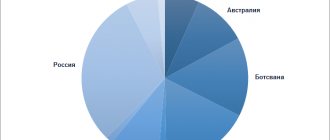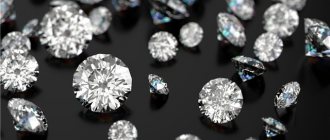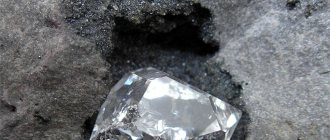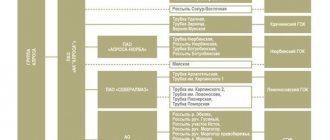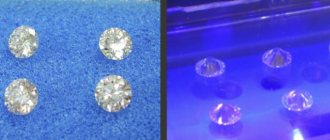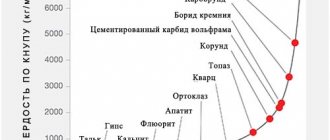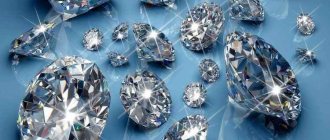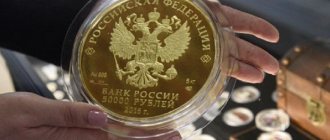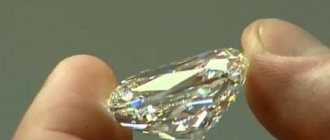In recent years, investing in diamonds has been gaining momentum. In today's unstable economic situation, they are becoming one of the best tools for investing money. Millions of dollars can be concentrated in a few grams.
It is quite possible that this type of investment will soon supplant stocks and real estate in the ranking of popular investments. Purchasing diamonds is becoming really profitable. Regardless of the purpose of the purchase, it is important to know how much a diamond is worth.
Cost of diamonds
Diamond and diamond have different values. A diamond is a stone mined directly from nature, often of a strange shape, sometimes with a large number of impurities, which practically does not play in the light. Only after cutting does it acquire a beautiful appearance and become a piece of jewelry—a diamond. The decisive role in cutting is played not by the chosen shape, but by its execution.
The master must preserve the weight of the stone as much as possible and cut it well.
An average quality diamond usually costs from $500 (30,000 in rubles) per carat.
The vast majority of mined diamonds are used to make polished diamonds. A diamond always costs 40-60% less than a ready-made diamond. Diamonds value purity and transparency. Defects are characteristic of all natural minerals. Some of them are visible to the naked eye, others are noticeable only at a tenfold magnification, which is common in jewelry production.
Stones weighing 0.01 carats are considered crumbs. A 1-carat diamond is a large stone. A top quality stone of 1 carat costs at least 20 thousand dollars. A diamond of average quality is estimated to be 3 times cheaper, while a defective one will cost 1-1.5 thousand dollars. Diamonds weighing more than 6 carats are sold only at auctions.
There are only 26 stones weighing more than 400 carats in the world. They have names and their own historical biography. The largest diamond, which amazed the world with its size, weighing 3106.75 carats, which corresponds to 621.35 grams, was accidentally found in 1905. It was named Cullinan after the owner of the mine.
A clearer white diamond has a higher price tag. The cost of white diamonds with yellow hues is much lower since they are more common. Fancy-colored diamonds must have a distinct color that is imparted by mineral impurities.
These stones are even rarer than white ones, so their prices are many times higher. The cheapest of the fancy colors is brown diamond, which is obtained due to an admixture of iron. A little more expensive than brown, yellow is a fancy color of diamonds with an admixture of lithium.
Very rare and expensive blue diamonds, which are obtained due to the aluminum content. The price of blue diamonds increases with the intensity of the color. Pink diamonds, which are obtained due to the presence of manganese impurities, are rare and very expensive.
The most expensive diamond in the world was the Pink Star diamond, weighing 59.6 carats, breaking all records for diamond prices. At Sotheby's auction, this largest of the pink diamonds was sold for $83 million in November 2013.
Blue diamonds produced by boron atoms are very rare. Some of the most expensive are green diamonds, which practically do not exist in nature.
The cost of a pure green diamond of 1 carat reaches 250 thousand US dollars. The most expensive and valuable is the red diamond, the price of which exceeds 300 thousand dollars per 1 carat. A limited number of red diamonds are found in private collections or museums.
Not everyone can afford a real diamond. Artificial diamonds are used as a substitute. To obtain an artificial analogue of a real diamond, 2 methods are used: the first is based on high temperature and pressure, the second is on the use of a gaseous environment.
One of the most popular artificial diamond analogues is cubic zirconia, which is made from zirconium oxide. The stone, distinguished by its excellent external characteristics, does not have high strength, so its price, compared to other artificial diamonds, is lower.
Another analogue of a diamond is moissanite, made from silicon carbide. Its unique shine and ability to shimmer in the sun have made it especially popular. Compared to other artificial diamonds, it is more expensive as it is highly durable. Products with artificial diamonds allow you to save significantly compared to jewelry containing natural stones.
Why are diamonds so expensive?
A diamond is a cut diamond that is chemically pure carbon (like graphite or coal). Why is the cost of a real diamond so impressive, while its close chemical relatives are valued at pennies?
The fact is that the birth of a diamond requires special conditions: high temperatures and monstrous pressure. Under their influence, carbon atoms are arranged into a particularly strong cubic crystal lattice, giving rise to the hardest substance known to science.
Similar conditions are naturally created deep in the bowels of our planet, so it is generally accepted that diamonds are born in the Earth's mantle (this is the most widespread and confirmed theory). Then, during geological processes, diamonds with other rocks are carried out or lie relatively close to the surface.
Some diamonds, called impact diamonds, came to us from distant stars. True, despite such a high origin in every sense, they are not of jewelry or investment interest.
Previously, it was believed that diamonds were born in water, because these incredible stones were found mainly in river sediments. However, over time, it was found that these minerals occur in kimberlite pipes - the vents of ancient volcanoes. This discovery was made in South Africa in the middle of the nineteenth century, near the town of Kimberley, where the name of the monstrous diamond-bearing springs came from.
Over time, it became clear that there are a lot of diamonds on Earth: they were not found only in Antarctica, and only because of the difficulty of searching. In Russia alone, several giant diamond deposits have been found and opened for development: in Yakutia, the Urals and the Urals, in the Arkhangelsk region.
Gold ring “Diamonds of Yakutia” (go to the SUNLIGHT catalogue)
However, not every diamond turns into a diamond - most stones are not clean, have a cracked structure, and contain many foreign impurities. They are classified as "board" and are used for technical purposes.
Mining kimberlite pipes is very expensive, and in order to find one grain of diamond suitable for cutting, hundreds of tons of rock have to be processed. By the way, they learned to process diamonds more or less decently only in the 15th century in India - from that time on, the world was gripped by a diamond fever.
This is why the cost of 1 carat of diamond in Russia and on the world market is so high. Development and cutting are very expensive, but that’s not all: a diamond becomes tens of times more expensive on the way from the mine to the final buyer.
Natural gem-quality diamonds are becoming increasingly scarce. And this is understandable: the age of these stones is hundreds of millions of years, and it is becoming increasingly difficult to mine them. The price rises accordingly.
At the end of the century before last, almost the entire world diamond market was controlled by the De Beers corporation. It was she who introduced the global fashion for jewelry with diamonds. The absolute monopolist monitored production (not a single stone passed his attention), ensured that consumers received fewer diamonds than required, and could dictate his own prices uncontrollably.
However, in the second half of the 20th century, the De Beers monopoly came to an end. Enormous reserves of diamonds were discovered in the USSR, but the Western company could not control Soviet production. Jewelry with diamonds born in Yakutia and cut there appeared on the shelves of Soviet stores.
Currently, the world diamond market is controlled by three giant companies. De Beers remains the leader, but its closest competitor is the Russian company ALROSA. It has already surpassed the former monopolist in terms of production volumes, but is still inferior to it in terms of the total cost of diamonds. True, African diamonds are considered the best in quality - among them there is a much higher percentage of the yield of jewelry stones.
The path of a diamond to be inserted into jewelry is long and thorny. It changes owners many times, losing in volume (after cutting, the stones “lose” at least half the weight), but gaining in price.
Gold earrings “Diamonds of Yakutia” (go to the SUNLIGHT catalog)
Cost of jewelry
The cost of domestically produced diamond jewelry starts from $500. The average cost of diamond jewelry from famous jewelry houses is about $1,500.
Diamonds that are accessible to the majority of the population are called folk diamonds. These are round-cut stones with a diameter of 3 mm and a weight of 0.1 carats, which are widely used in earrings, pendants, and rings.
The cost of these stones is relatively low: depending on color and clarity, it ranges from 60 to 120 US dollars. A diamond set in gold will cost twice as much. It is much more profitable to purchase unmounted certified diamonds and then order a setting from a jeweler.
Examples of calculating the cost of one carat diamonds
By combining different characteristics of a gemstone, you can roughly calculate its value. Thus, a one-carat round diamond, rated as absolutely colorless (color category 1(D)) and having the highest clarity 1(IF), costs approximately 2 million rubles . However, if you purchase exactly the same diamond of color category 4 (G), purchasing a crystal that is almost no different in appearance from the previous version will cost about 1 million rubles .
One carat of an oval-cut diamond with color 1(D) and clarity 1(IF) costs much less than a round crystal - about 1.5 million rubles . Cushion, princess, marquise, radiant and pear cut stones of the same quality have approximately the same price.
The cheapest options are champagne-colored minerals (6(I), 6.1 (J), 7(K)). One carat of such stones of any cut, except round, which is more expensive, costs from 400,000 to 550,000 rubles with a clarity of 1(IF). If such a diamond is of medium purity, then its price will be only 250,000 rubles .
What determines the price of diamonds?
The price of a jewelry stone depends on 4 factors:
- Weight is the main indicator
- Color - determined by reference samples
- Cleanliness - presence and nature of defects
- The cut depends on the skill of the jeweler.
This is interesting: Natella Krapivina and Loboda Relationships
In addition, important importance is given to the precious stones market, namely the relationship between supply and demand. In Russia, according to statistics, for several years now the most sold stones have been 0.1 carat stones. Their cost on average is estimated at 7-8 thousand rubles.
Focus failed
EBITDA is earnings before interest, taxes, fees, depreciation and amortization. The indicator records how successfully and efficiently a business operates. The indicator is useful to evaluate companies in the same industry that have different ownership structures. One of the most important indicators for investors and shareholders who decide to invest in a company.
However, the record level of production did not have a positive impact on the company’s financial results - the 60th anniversary year for the Russian diamond giant turned out to be anything but festive. The state-owned company's profit in 2022 fell 1.7 times, to 78.6 billion compared to 133.5 billion rubles a year earlier. EBITDA decreased by 28 percent and amounted to 127 billion rubles. The company explained the gloomy financial performance by the strengthening of the ruble exchange rate and a decrease in the average price of jewelry diamonds sold on world markets.
Production in 2022 could have been even higher if not for the accident at the Mirny Mining and Processing Plant (GOK). The incident occurred on August 4, 2022, water broke into the mine and flooded it. At that moment, there were 151 people below, 142 of them were rescued on the same day, the next day another miner climbed out of the destroyed mine. For eight people, “Mir” turned out to be a mass grave. According to the conclusions of Rostekhnadzor, the accident was caused by violations of design solutions and industrial safety rules.
“Mir” is the oldest mine of the state company; in fact, Alrosa was born from it. A kimberlite pipe was discovered in the west of the Yakut Autonomous Soviet Socialist Republic back in 1955. After the discovery of the first diamonds, exploration geologists sent an encrypted radiogram to management: “We lit a pipe of peace, the tobacco is excellent.” Within two years, industrial mining of precious minerals began at the deposit. In 2016, the mine accounted for less than 9 percent of Alrosa's diamond production, or about 3 million carats a year.
Photo: Sergey Subbotin / RIA Novosti
The accident cost Alrosa 10.2 billion rubles. As a result of the investigation, the director and chief engineer of Mir were fired. In 2018, the company will not be able to repeat the successes of 2022 - diamond production is projected at 36.6 million carats, a decrease amounting to the same share that . The head of the Alrosa sales directorate, Evgeny Agureev, said that in 2022 the company will try to increase production at other fields. The state-owned company does not intend to give up its position in the sale of diamonds, therefore, contrary to the promise to the Prime Minister, the company will liquidate its own reserves. At the end of 2022, Alrosa’s reserves were estimated at 18 million carats. Agureev calls the volume of reserves at the level of 12-14 million carats “comfortable”; in 2022, the company intends to sell about 4 million carats from its own reserves.
Price of 1 carat diamond in rubles, how much do the stones cost?
Investing in precious stones today is considered by many as a successful investment, since, regardless of currency fluctuations, gold or diamonds always have a high price. However, before purchasing them, you need to be able to understand the stones. It would be nice to understand what factors determine the price of 1 carat of diamond in rubles and how they may differ from each other.
Without a single edge
Russia occupies a tiny share in the global diamond cutting market - only 3-4 percent, losing out to competition from the huge Indian industry. Jewelers in India process 12 of the 14 diamonds sold in the world. The secret of Indian success is not only in the traditions of jewelry making and the gigantic local market, but also in the availability of cheap labor.
Russian cutters worked with Alrosa on a common basis until 2022. With foreign ones, it turned out that Russian companies did not receive any priority over foreigners when selecting rough diamonds. According to Reuters, Alrosa now has 65 regular buyers (of which only eight are Russian) for jewelry and industrial diamonds, contracts with which are concluded for three years. In January, the supervisory board of Alrosa obliged to increase supplies of rough diamonds weighing more than one carat to Russian cutting enterprises. The decision was made with the participation of Finance Minister Anton Siluanov, who heads the supervisory board of the state-owned company.
Photo: Dmitry Korotaev / Kommersant
Also, to develop the diamond cutting industry, Alrosa allowed cutting companies to pay up to 75 percent of the cost of diamonds in installments for six months. Previously, this share was 50 percent - companies often did not have time to complete the work and sell the product; the new rules should help domestic cutters. The key lobbyist for expanding the rights of cutters on the Russian market is another state-owned enterprise - cutting, which is 100 percent owned by the state. This company accounts for about 40 percent of all Russian diamonds.
Deputy Finance Minister Alexei Moiseev admitted in March that the state would go ahead with the privatization of Kristall, but the official did not talk about the timing or volume of the placement. Of course, Alrosa is showing interest in the main cutting enterprise in Russia.
Investment in stones
There are a large number of different ways to invest money, many of them cannot be called reliable. If a person wants to invest in precious stones, then he should know the advantages of this:
the demand for high-quality precious stones, including diamonds, is constantly growing, as is their price;- diamonds have high liquidity, convertibility is maintained regardless of global or local crises;
- Precious items are not registered by the state, so they cannot be confiscated during legal proceedings.
All these advantages allow diamonds to be an excellent investment value, which is very important in conditions of constant crises and currency falls. There are world centers that mine precious stones - diamonds or rough diamonds, and they also process them. Financial specialists are actively interested in this industry.
The bulk of supply comes from jewelry cutting centers. They are located in the following countries :
An important indicator is how much diamonds cost on the market (1 carat). The cost depends on several factors, which you must carefully study before purchasing them. It is advisable to study different offers.
How to withdraw
Knowing how to get diamonds and what they give, you can broadcast, interest users and accumulate gifts. In case of successful streams, it is worth checking the number of accumulated diamonds and withdrawing them into real money. To do this, follow these steps:
- Go to Tik Tok and go to Profile.
- Click on the three stripes at the top right.
- Enter the "Wallet" section.
- Go to the “Gifts from Live Broadcasts” section and look at the total number of diamonds and balance.
- Go back and go to the “My Income” section.
- Here click on “Withdraw” and request the amount if it is more than the minimum.
Main assessment factors
Stones are assessed by gemologists and experienced jewelers. The price per carat of a diamond today depends on current changes in the core market, but the costs of mining precious stones create lower costs.
The final price is determined by the following characteristics of the stone:
its weight and size;- degree of purity;
- shade;
- cuts.
Different countries have different metric systems, but the most common method of measurement is the American one. The stone does not need additional testing if it has been evaluated by the Homology Institute of the United States. The test results are then converted into other units.
In Russia, the stone evaluation system will be very different. Accordingly, the cost of a carat of a diamond in rubles in the Russian Federation may differ from stones from America.
Diamond pricing in Russia
It was said earlier that the cost of a diamond’s carat is determined by its parameters, clarity, color and cut. In the Russian Federation there is a standard for their assessment, which was adopted already in 2002.
1 carat contains 200 mg . This measure got its name from a type of tree whose seeds had the same size and weight, equal to 0.2 g. In ancient times, they were used as a measure of weight.
The cost of a diamond depends on its weight; the larger it is, the more expensive it will be. Small stones weigh a maximum of 0.29 carats, medium ones - from 0.30 to 0.99, respectively. But those considered large will weigh 1 carat or even more.
Cut is an important factor when choosing a stone. The more attractive it is, the more likely it is that the buyer will be interested in it. The most in demand are medium-sized round stones, which have from 17 to 57 facets.
The next evaluation factor is the color of the diamond. Its variety of shades starts from completely colorless and ends with colors such as:
The most highly valued are colorless diamonds, which are invisible even in water. A pure diamond is an expression about just such people.
The purity of stones has several groups; it is determined using a magnifying glass. The most expensive class is first. The stones that belong to it do not have any cracks or other inclusions.
Determining the exact cost
The price range is incredibly wide. A product that has the highest color and purity indicators will cost 120-300 thousand dollars. But what was rated as average or below average quality will cost from 3 to 9 thousand dollars.
For Russian buyers, it is especially important how much 1 carat of diamond costs in rubles. If we talk about large jewelry, then 1 carat will cost about 500 thousand rubles. The most common stones among buyers are those weighing 0.1 carats. The cost is approximately 7 thousand rubles. One carat, accordingly, will cost 70 thousand rubles.
Only a professional specialist can evaluate a stone correctly, depending on its parameters and quality. A finished ring equipped with a stone will have a price depending on its characteristics, but you need to remember that the cost of a stone as part of jewelry will be lower than in its pure form.
Very sharp eye
The company is run by Sergei Ivanov Jr., the son of the former head of the Russian Presidential Administration Sergei Ivanov, who has now faded into the shadows of environmental issues. Before Alrosa, Ivanov Jr. did not work in the diamond mining or related industry; his track record includes the investment subsidiary of Gazprom, Gazprombank, SOGAZ, Rosselkhozbank. Russian Prime Minister Dmitry Medvedev appointed Ivanov Jr. to the post of president of Alrosa on March 6, 2022. The contract with the top manager was concluded for three years. Ivanov, in turn, promised the prime minister to increase the company’s reserves, increase diamond production, get rid of non-core assets and modernize production.
Sergey Ivanov
Photo: Maxim Blinov / RIA Novosti
In February, Ivanov told Russian President Vladimir Putin about his production successes. “The company reached a record level of diamond production at the end of 2022. This volume was last recorded in 1990. We have mined almost 40 million carats of diamonds,” said the head of Alrosa.
How much are diamonds worth?
People who are interested in diamond prices are also interested in diamonds. It is worth saying that the cost of diamonds largely depends on price fluctuations on the market for cut diamonds.
This is interesting: How to clean a toilet from limescale
Diamonds in the rough will cost twice as much as processed diamonds. The price of a diamond includes a high discount, which covers cutting costs, as well as the risks that the stone will be damaged during processing or will be of lower quality than originally planned.
Diamonds are graded by color and clarity. The final cost depends on the number of carats and other indicators. On average, a 1 carat diamond is twice as expensive as a diamond. In natural conditions, diamonds can have different colors and different degrees of purity.
When it comes to small round diamonds with 17 facets, they are divided into four classes from colorless to brown. If it is round and large and has 57 edges, it will only need to be assessed by a specialist. All nuances are taken into account - from the color of the stone to microcracks.
You can evaluate the stone yourself using a special table that lists different groups of diamonds by color and clarity. For example, when it comes to cleanliness, the FL value means that it does not have any cracks or inclusions, and the I sign means that there are many inclusions and they are noticeable. The cost in different cases will differ, sometimes even quite significantly.
If you want to sell such an item, you cannot set the price yourself without a preliminary assessment, especially without thoroughly understanding the issue of pricing.
Real diamonds and high quality diamonds cannot be very cheap. A suspiciously low cost in any currency should alert you. This is probably a fake or extremely low quality. There is no exact price for these products; it is advisable to evaluate them separately each time depending on their individual characteristics.
What is more expensive, a diamond or a diamond?
The question of what is more expensive, a diamond or a diamond, is initially incorrect. As we know, the price of a diamond per gram can be extremely low when it comes to “cuts,” that is, technical stones.
We can talk about the price of jewelry stones only taking into account their characteristics. But roughly we can say: the price per carat of a diamond after cutting increases by about 3-5 times, and this is not the limit! But inept cutting can ruin the most promising diamond.
Diamond prices in Russia are maintained at the international level and depend on general trends in the global diamond market. If you want to know the current position on the market of these delightful and very expensive stones, follow the updates in Rappoport’s price list.
Gold ring “Diamonds of Yakutia” (go to the SUNLIGHT catalogue)
If you purchase jewelry from a well-known brand such as Tiffany or Cartier, be prepared for the price of the stones to rise significantly. In this case, you pay not only for diamonds, metal and work with all the markups, but also a big name.
DIAMOND PRICES FROM 0.5 TO 1.99 CARAT
First of all, it is worth noting that diamonds, although they do not wear out or change over time, are classified as personal goods. And like most personal goods, diamonds have a first purchase price.
and
resale price
. The selling price on the secondary diamond market is 20-40% of the prices of jewelry stores and 60-80% of the prices of companies specializing in diamonds. This difference is due to the trade margin, the quality of the diamonds, and the presence of a reputable certificate (you can read more about certificates here). According to the analysis of the diamond market, diamonds with a GIA certificate lose the least in price, in the range of 0.5-1.5 carats, with average characteristics (color: FH (3-5), clarity VS-SI (5-7a)).
You can learn about the factors influencing the price of a diamond in the Diamonds and Prices section. To make a preliminary assessment of the cost of a diamond, you can use one of the following options:
How to compare diamond prices correctly? The price of each individual diamond is made up of many factors, for example, diamonds with the same clarity rating (eg SI1) but with different types of inclusions will have different prices. In the same way with the color of a diamond, for example, color 5 (H) according to standards can have a yellowish, lilac, gray or brown tint. The last shade (brown) significantly reduces the price of the diamond. This is explained by the fact that with the same intensity of brown and, for example, yellow, the brown color is perceived by the human eye as darker. There are even more nuances in the quality of cutting, symmetry, and polishing. Therefore, it is not so easy to compare diamonds. For a superficial comparison, you first need to make sure that the diamonds were certified by the same laboratory. This is extremely important, because the characteristics indicated in the certificates of commercial laboratories (primarily EGL, IDL, IGL and others) are several orders of magnitude higher than the reference (real) assessment of the Gemological Institute of America (GIA). It is impossible to guess how high the characteristics are in this case, therefore, the comparison will be extremely inaccurate. You can read more about commercial certificates in the section “Certificates of commercial laboratories”. If the certificates are similar, weight, color, clarity are also of the same order, it is necessary to check the quality of cut, polishing and symmetry. The price difference between excellent cutting and polishing quality (Excellent) and good quality (Good) reaches 30%. The last important point affecting the price is fluorescence. The highest level of fluorescence is Very Strong Blue, which also reduces the price of the diamond by 5-10%.
shown for round A-cut diamonds are indicative and may vary depending on the Rapaport price list. Diamonds weighing up to 0.2 carats are sold only in lots (from 2 carats). Diamonds weighing more than 0.3 carats are accompanied by a GIA
(Gemological Institute of America).
To more accurately calculate the cost of diamonds , use our calculator or diamond selection wizard.
The terms of use of the calculator and selection wizard can be found on this page. from 0.5 to 0.69 carats
Price per 1 carat in USD
| ColorPurity | 5 | 6 | 7 | 7a | 8 |
| 4 | 4700 | 4200 | 3700 | 3000 | 2600 |
| 5 | 4200 | 4000 | 3400 | 2800 | 2500 |
| 6 | 3400 | 3300 | 3000 | 2600 | 2400 |
| 7 | 3000 | 2800 | 2700 | 2500 | 2200 |
| 8 | 2500 | 2400 | 2200 | 2100 | 1800 |
from 0.7 to 0.89 carats
Price per 1 carat in USD
| ColorPurity | 5 | 6 | 7 | 7a | 8 |
| 4 | 5600 | 5300 | 4700 | 3800 | 3500 |
| 5 | 5200 | 4800 | 4400 | 3600 | 3200 |
| 6 | 4500 | 4300 | 3800 | 3200 | 2900 |
| 7 | 3500 | 3300 | 3100 | 2900 | 2600 |
| 8 | 2900 | 2800 | 2600 | 2400 | 2200 |
from 0.9 to 0.99 carats
Price per 1 carat in USD
| ColorPurity | 5 | 6 | 7 | 7a | 8 |
| 4 | 7400 | 6800 | 6100 | 5300 | 4400 |
| 5 | 6800 | 6400 | 5700 | 5000 | 4100 |
| 6 | 5900 | 5600 | 5300 | 4600 | 3600 |
| 7 | 5000 | 4700 | 4500 | 4100 | 3300 |
| 8 | 4100 | 3900 | 3600 | 3400 | 2900 |
This is interesting: Lower Body what is it in Fitness
from 1 to 1.49 carats
Price per 1 carat in USD
| ColorPurity | 5 | 6 | 7 | 7a | 8 |
| 4 | 8900 | 8100 | 7300 | 6100 | 5400 |
| 5 | 7800 | 7400 | 6700 | 5800 | 5000 |
| 6 | 6900 | 6600 | 6200 | 5400 | 4700 |
| 7 | 5900 | 5700 | 5300 | 4800 | 4200 |
| 8 | 4600 | 4400 | 4200 | 3900 | 3600 |
from 1.5 to 1.99 carats
Price per 1 carat in USD
| ColorPurity | 5 | 6 | 7 | 7a | 8 |
| 4 | 11700 | 11100 | 9800 | 7700 | 6600 |
| 5 | 10100 | 9700 | 9000 | 7300 | 6200 |
| 6 | 8400 | 8100 | 7700 | 6600 | 5700 |
| 7 | 7200 | 6800 | 6400 | 5800 | 4900 |
| 8 | 5900 | 5500 | 5200 | 4800 | 4300 |
from 2 to 2.99 carats
Price per 1 carat in USD
| ColorPurity | 5 | 6 | 7 | 7a | 8 |
| 4 | 16500 | 14900 | 12900 | 10300 | 7200 |
| 5 | 14400 | 12900 | 11300 | 9800 | 6700 |
| 6 | 11500 | 10800 | 9800 | 8800 | 6200 |
| 7 | 9300 | 8800 | 8200 | 7200 | 5700 |
| 8 | 7700 | 7200 | 6700 | 6200 | 5200 |
A moderately trained eye does not see the difference between color groups 1 and 6 if the diamond is viewed from the side of the crown, mounted, and in the lighting conditions of a jewelry store. The price difference between groups 1 and 2 of purity and color can reach 150%.
Kr57 3/4 0.1. Kr57 - means the shape of the stone and the number of facets, in this case the cut is round and there are 57 facets on the stone (standard diamond cut). The next number indicates the color, followed by the purity, and the last number indicates the number of carats.
How much does a diamond cost approximately?
Talking about the price of a 1-carat diamond in rubles is the same as talking about the cost of cars in the same way. We don’t know whether we are talking about a Maserati or a Lada Kalina?
Simple calculations are not applicable here: the price of a 3-carat diamond and its fellow 2-carat diamond can be equal - it all depends on clarity, color, cut quality, and so on. And sometimes a small diamond with rare characteristics costs thousands of times more than its larger counterpart. For example, the cost of a carat of the rarest red diamond amounts to millions of dollars!
It’s also difficult to say how much a rough diamond costs: no one knows how much the stone will lose after processing, and unprofessional cutting can significantly reduce the cost of the stone. And why? Rough diamonds still do not go on public sale: they are traded from exchanges and bought either by intermediaries or large jewelry companies.
For approximate calculations of the cost of stones weighing up to 5 carats, you can use the Tavernier principle. Based on it, the cost of a diamond is equal to the square of its mass, expressed in carats, multiplied by the cost of one carat.
The price of a diamond ring with good characteristics and decent weight will be higher than a similar one with small stones. A carat of a large diamond costs much more than a carat of small diamonds!
You will not find jewelry with a pure natural diamond of 10 carats in stores, even if you are willing to pay a fantastic amount for it. Stones heavier than 6 carats are sold mainly through auctions, and stones heavier than 25 carats acquire their own names and become part of the history of jewelry.
What determines the cost of a stone?
Around the middle of the 20th century, the first attempt was made to unify the diamond grading system. It turned out to be so successful that now the system introduced by the GIA (Gemological Institute of America) is considered the most authoritative in the world.
Over the past decades, many similar systems have been proposed, both international and national. Now every diamond sold on the international market must have a certificate describing its characteristics.
Already cut stones are evaluated: for raw “diamonds” such a clear gradation cannot exist! Stones of synthetic origin are much cheaper than their natural counterparts and cannot be compared with them.
Another subtlety: stones that have undergone any changes other than cutting (painting, oiling, radiation exposure, heating, etc.) are not considered truly natural and are not graded according to the GIA system below.
The most authoritative certificates are those issued by non-profit organizations (in addition to the GIA, these are AGS, HRD and IGI). There, stones are evaluated anonymously, and the cost of the examination does not depend on the result or the person of the customer. Commercial organizations also examine stones, but the certificates they issue often raise concerns regarding objectivity.
Russian diamonds are evaluated according to their own system, approved by GOST R 52913-2008 (or the corresponding specifications). The Russian system has something in common with the GIA, but is not identical to it.
Within Russia, diamond certification is not mandatory. For ordinary buyers, the “passport” of the stone is the tag attached to the diamond jewelry with a seal.
According to the Russian system:
- Only classic round cut diamonds (17 or 57 facets) are evaluated;
- have their own designations (digital, not lettered);
- Diamonds of fancy shades (except for yellow and brown, provided for in the general table) and alternative cuts are not evaluated.
The GIA certification system offers the following characteristics by which a diamond is assessed: color, clarity, carat weight, cut.
These “four Cs” cover the most important characteristics of a stone that influence pricing. Knowing them, you can use a diamond cost calculator and calculate the approximate price of the stone.
Color
The main GIA table includes colorless diamonds and those close to them. The ideal sample is impeccably white, with a slight bluish tint allowed. The more yellowish or brownish, the worse the quality of the stone and the lower the price. The color of stones is graded on a letter scale, from D to Z. That is, the highest grade of D is given to perfectly colorless stones, Z - quite intensely colored due to the presence of nitrogen atoms.
Why does the GIA marking begin with the letter D, and not from the beginning of the alphabet? American gemologists suggested that there might be even “more colorless” stones, and just in case, they reserved the first three letters of the English alphabet for them.
According to the domestic GOST, diamonds are marked by color in numbers (from 1 to 9-4), and the number of facets and the weight of the diamonds are taken into account.
Diamonds of rare fancy colors are graded on a separate GIA scale (more on that later), in Russia - individually.
Clarity (purity)
Another important parameter is the purity or clarity of the stone. As you know, nature introduces some features of imperfection even into its best works, and diamonds are no exception in this regard. There are simply no stones of natural origin that are completely free of defects!
Each stone is carefully examined through a magnifying glass with 10x magnification, then a verdict is made, and the diamond receives a clarity rating. According to GIA, this parameter is expressed in letter abbreviations, according to GOST - traditionally in numbers.
Experts study not only the number of defects, but also their shape and location. The most inconspicuous are light dots, their clouds, “feathers”, the brightest are dark dots and voids.
The location of the defects is fundamentally important. One point, but located in the middle of the area, will be reflected in all facets of the diamond. And a few defects located along the edges or bottom of the stone will not be so noticeable, especially in the setting. This also affects the price.
Gold brooch with diamonds (go to the SUNLIGHT catalogue)
Carat weight (weight in carats)
The generally accepted unit of measurement for the weight of gemstones is carats. One carat is 0.2 grams. A stone weighing one carat is already quite impressive and looks very presentable in jewelry - it is as much as 6.9 mm. He is considered large. Pebbles weighing up to 0.29 carats are considered small, while stones weighing up to 0.99 carats are considered medium.
Jewelry in the public category usually contains “folk diamonds” - weighing about 0.1 carats, slightly larger than diamond chips.
All other things being equal (color and purity), a large stone is significantly more expensive than a smaller one, and the progression here is geometric.
Cut
The traditional cut is considered to be the so-called “diamond” cut, with 57 facets (in Russia, small diamonds are sometimes cut with 17 facets). In addition to it, there are various types of fancy cuts: “Princess”, “Pear”, “Cardinal”, “Heart”, “Trilliant”, “Emerald” and so on.
The diamond cut is valued above others, so jewelers try to give diamonds this particular shape, but this is not always possible due to the natural characteristics of the stone (location of defects, original configuration, cracks, etc.).
Now, special programs have come to the aid of jewelers, allowing them to calculate the optimal cut for each sample individually. Some large diamonds have to be sawn into several pieces to avoid cracking and eliminate defects.
Not only the shape is assessed, but also the quality of the cut (proportions, symmetry, polishing). An ideal diamond should reflect up to 99% of the rays that hit it. A 100 percent rate is unattainable even for synthetic minerals.
In the Russian classification, the quality of cut is assessed according to a general table only for round stones: diamonds of fancy shapes are examined personally.
Pricing Basics
Most of the diamond cost calculators available online are based on calculations using the aforementioned Tavernier system. And the cost of a carat is set primarily by the largest players in the world diamond market.
Every two weeks, the GIA publishes the so-called “Rappoport Tables,” which are recommended prices for diamonds depending on their weight, clarity and color. Fancy cut diamonds are placed in a separate table and are priced slightly lower than classic round diamonds.
Rappoport's price list is approximate: sellers are not obliged to follow it. Moreover: samples with excellent cutting are traded approximately 5-20% higher than the stated price. And stones located at the upper limit of the weight set for a specific group add another 20% to the price - at the Oversize markup.
Gold bracelet with diamonds (go to the SUNLIGHT catalogue)
Large stones (from 6 carats), which have received the highest and highest ratings for clarity, color and cut, are fantastically expensive and are sold at auctions. Outstanding specimens receive names. They are outside the tables, and the cost per carat of such a stone can be expressed in 6-7 figures (of course, in dollars).
If you are choosing the best investment option, pay attention to stones with characteristics from 3/3 to 6/6, weighing 1-3 carats. They are as liquid as possible and do not lose value when sold. Large registered pieces are constantly becoming more expensive, but only a select few can afford them.
Experts recommend purchasing medium and large diamonds separately, always with a reputable certificate, and then setting them into custom-made jewelry. This will cost less, and the seller will not be able to hide the defect under the frame.
Diamonds Fancy
Typically, the presence of impurities reduces the value of diamonds, but there are exceptions to this rule. They concern mainly colored stones, which Nature, by some unknown whim, has endowed with bizarre shades.
Approximately 2% of all mined diamonds are classified as Fancy and are graded according to the GIA personal system separately from colorless diamonds. They are usually even cut differently in order to demonstrate the purity, uniformity and beauty of the shade, which is a priority when pricing.
The purer and more saturated the color, the more expensive the diamond. Only flawless transparent diamonds can compete with rare fancy diamonds in price, and even then not always.
There are no price lists or recommended prices for fancy diamonds - they are rare and individual. At least some information on this issue can only be obtained by analyzing real transactions, mainly through Sotheby's and Christie's auctions.
Among the fancy colors of diamonds, it is customary to highlight:
- Yellow. A distinction should be made between colorless diamonds, which have received an undesirable yellowish tint due to nitrogen impurities, and true yellow diamonds with a rich color. The most famous representatives of this noble family are the legendary “Sancy” and the fantastic “Drop of the Sun” weighing 110.3 carats. Less outstanding examples cost 14-17 thousand dollars/carat.
- Orange. We are looking at an incredible rarity, the price of which starts at 60 thousand dollars per carat, and such diamonds are usually not large. But there are exceptions, for example, the sunny “Orange” weighs as much as 14.82 carats.
- Pink. In fact, this is a variation of a brown diamond, but in a beautiful pink hue. It is believed that a pink diamond acquires a unique color already at the “output” due to the displacement of atoms in the crystal lattice. There are many named champions in this category: “The Little Prince”, “Sweet Josephine”, “Pink Star” and others like them. An average stone is traded from 150 thousand dollars per carat.
- Cognac (or brown). This is perhaps the most common and inexpensive shade generated by iron impurities. Most brown diamonds on the market today are of Australian origin. The average market price is 5 thousand dollars/carat.
Gold earrings with cognac diamonds (go to the SUNLIGHT catalogue)
- Reds. Stones of a rich red color are vanishingly small: it is believed that there are no more than fifty specimens in the world, and the whereabouts of half of them are unknown. This determines the truly fabulous cost of a red diamond - about 1.5-2 million dollars per carat. And this despite the fact that stones weighing over 5 carats can be counted on the fingers of one hand. All red diamonds are unique!
- Blue and blue. The rare and beautiful blue color is given to diamonds by admixtures of aluminum and boron. The most famous member of the blue diamond family is the infamous Hope (45.52 carats), which is in the Smithsonian Museum and has not been traded for more than half a century. And its closest competitor, the magnificent Wittelsbach, weighing over 35 carats, was recently sold for $80 million. The price of a blue diamond of less outstanding condition is about 160 thousand dollars per carat.
- Green. Chlorine atoms and/or radiation are responsible for the spectacular green tint - gemologists have not come to a common point of view. There are relatively many diamonds with a greenish tint, but there are only a few pure green ones. All true green diamonds are known by name and have their own names. At the moment, they set an absolute record in terms of price - about $3 million per carat.
- White and grey. Here are rare, but relatively inexpensive stones, estimated at around 5 thousand dollars per carat. White samples are characterized by opacity and are somewhat similar to opals, but with a characteristic cut (opals are cut as cabochons). Gray stones contain a lot of impurities and belong mainly to the “pique” category. Until recently, diamonds of this kind were considered technical and were not loved by jewelers, but in recent years interest in them has been constantly growing. Most natural black diamonds that retain some transparency also fall into this category. The most famous of them is the brutal “Black Orlov” (actually gray), which has not been put up for auction for a long time.
Due to the fact that the cost of colored diamonds is constantly growing, they are often given a rich color artificially: irradiated, heated, oiled, and so on. Such samples are immeasurably cheaper than stones with pure natural color.
Why is stone so expensive?
A diamond is a processed version of a diamond . Minerals mined in special mines are carefully processed, cut, and only then used to decorate jewelry.
The high cost of the stone is due to the fact that there are quite a few diamonds in the world; they are mined in only a few countries (including Russia). The processing process also requires special attention and a long time, so the jeweler’s labor is also paid additionally.
The price of diamonds is also influenced by the fact that they are considered particularly prestigious stones. Large jewelry stores charge a premium for the brand, because the buyer receives a product from a well-known brand.
How to buy
Many questions concern how to buy diamonds on TikTok, because they make a profit. This cannot be done, because they accumulate only when receiving gifts, and later they are exchanged for cash. To obtain information about the number of diamonds, you need to go to the “Wallet” section and look at the balance. Please note that the minimum withdrawal amount is $100 and the maximum is $1,000.
What does the cost depend on?
According to common practice, the value of diamonds is measured in US dollars. The price of a particular stone depends on 4 factors:
- Purity. In the most expensive specimens there are practically no foreign inclusions or they are very small in size.
- Weight. A standard diamond is up to 2 carats in size. Larger format minerals are valued according to a special system, and the largest of them are so expensive that they are only purchased by museums or collectors.
- Cut. The more edges there are on the stone, the more accurately they are applied, the higher the price will be.
- Color. Brown-colored diamonds are the least expensive, while blue, red, and green-colored diamonds are the most expensive.
It is worth noting that many points taken into account when assessing the cost of a stone are subjective. For example, the quality of a diamond's cut is determined by a specific seller or exchange.
How to recognize a diamond
The popularity of the jewelry and the enormous interest in it led to the creation of artificial analogues. Having an external resemblance to natural stone, substitutes (cubic zirconia, moissanite) lack its unique natural qualities.
This is why it is very important to be able to distinguish a diamond using available methods.
Differences from synthetic stones
- The main difference is the absence of natural inclusions and defects in artificial analogues, which are always present in diamonds (except for the most unique ones). To identify them, it is enough to use a magnifying glass with 10x magnification.
- You can distinguish by trying to read the text on a white sheet through a sample. A fake will allow you to see the words, a real one will not.
- You just need to breathe on the stones - synthetic ones will fog up.
- You can put the specimens under study in a plastic lid with water, place it on a white sheet and shine a flashlight on top. The glare of the jewel is like the flame of a gas burner; long rays of different colors emanate from artificial substitutes.
- When immersed in water, a diamond's edges are visible without glare; cubic zirconia and moissanite have a glare. You can also touch the surface with a wet needle or toothpick - the drop will not spread.
Types of diamonds
Diamonds of different colors and sizes are found in nature. The most common are transparent stones of a yellowish tint, reaching a weight of up to 1 carat. They are the ones most often used in the jewelry industry. Blue or blue diamonds are in greatest demand among jewelry connoisseurs.
When working with diamonds, jewelers give them different shapes. The most common are round specimens. Fancy cut stones will cost much more: pear-shaped, heart-shaped, drop-shaped, etc.
Types of Diamonds
Jewelry varies in size, color and cutting method.
Size
Diamond crystals come in different sizes - from microscopic to quite large. A mineral weighing more than 15 carats is rare. There are only 26 nuggets heavier than 400 carats, they are given names. The largest, named "Cullinan", weighs more than 3,107 carats (more than 600 grams).
The most common diamonds weighing 0.1-1.5 carats.
Color
The color is determined by the composition, amount of impurities, as well as the structure of the diamond. Shades can be barely noticeable, insignificant and pronounced.
The most common and cheapest are pale nuggets of various shades, especially yellowish and smoky brown; stones of pale green, mauve, and blue tones are much less common. They are much more expensive.
Rich golden and wine-yellow minerals mined in Australia are considered exquisite.
Ruby and cherry are extremely rare, and even more rare are black, bright green and purple. Once cut, their price is very high.
Cut
Initially, the cut consisted of 16 facets - 8 each in the upper and lower parts of the stone (the so-called ordinary or simple).
A little later, the number of facets increased to 32 - 16 at the bottom and at the top; this cut received the name of Cardinal Mazarin (another name is double).
In the second half of the 17th century, the Venetian jeweler Vincenzo Peruzzi created a cut, later called brilliant, with 57 facets.
It has become the most common and is used for processing nuggets weighing more than 0.3 carats. At lower weights, 17 or 33 facets are usually created.
Later, more complex methods were found with 73, 86, 102, 146 faces. They are used when processing large, unique diamonds.
Approximate prices
If you decide to purchase a diamond for jewelry or as a savings option, be prepared to pay at least $500 for the stone. Approximate prices for 1 carat are as follows.
- from 30,000 rubles - for a stone of average quality (with inclusions and not particularly neat cutting).
- from 60,000 rubles - for a clean diamond with a good cut.
- from 150,000 rubles - for a cushion-shaped stone of medium purity.
- from 200,000 rubles - for a round diamond of the highest purity.
- from 350,000 rubles - for a round yellow specimen of ideal purity and transparency.
- from 1,200,000 rubles - for a stone of 8 carats or more of good quality.
Some stores offer 1 carat diamonds at prices significantly lower than listed. Most often, these are either rejected stones or pressed from dust left over after cutting, rather than genuine minerals.
Characteristics of diamonds
All 4Cs have a classification – international and according to Russian standards. It allows you to accurately determine the properties of a piece of jewelry that determine its price.
Color
White diamonds are graded by color on a scale from D (1) to Z, where D is extremely colorless (pure water) and the most expensive, and Z is a much cheaper light yellow stone.
In the interim:
- E (2) - absolutely colorless;
- F (3) – simply colorless;
- G(4)-H(5) – very slightly different from colorless;
- I (6)-J (6.1) – light yellow tint;
- K (7)-L(8)-M(9) - faint yellow tint;
- NZ – from a pronounced yellow tint to yellow.
Designations according to the Russian classification are shown in brackets.
Purity
The purity groups are shown below.
| Group (in brackets – Russian classification) | Characteristics of inclusions and defects | Impact on price |
| IF (1) | None | Very rare, expensive |
| VVS1 (2), VVS2 (3) | Insignificant, visible only at 10x magnification | Rare, expensive |
| VS1 (4), VS2 (5) | Very small, not visible to the naked eye | High quality |
| SI1 (6), SI2 (7), SI3 (8) | Slightly, hardly noticeable | Good quality |
| I1 (9), I2, I3 | Visible to the naked eye | Average quality |
Cut
According to the shape, the cut is divided into round and fancy. The second can be varied - pear, drop, etc. The types of cuts are illustrated in the figure.
The cutting method is determined by the shape and size of the diamond.
The cut has the following classification:
- ideal (A) – the highest level of cut with optimal light reflection and sparkle;
- very good (B) – a significant part of the light is reflected, the gloss differs little from class A;
- good (B) – most of the light is reflected, this is a compromise option for the combination of price and quality.
